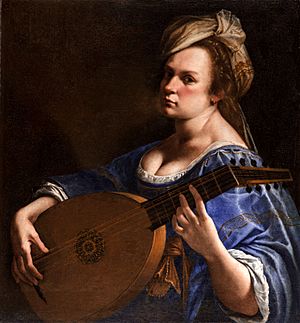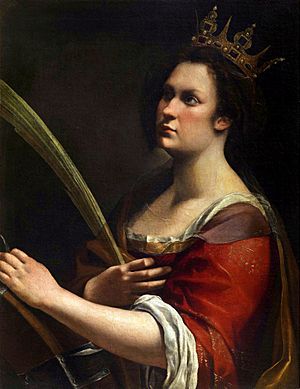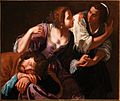Artemisia Gentileschi facts for kids
Quick facts for kids
Artemisia Gentileschi
|
|
|---|---|
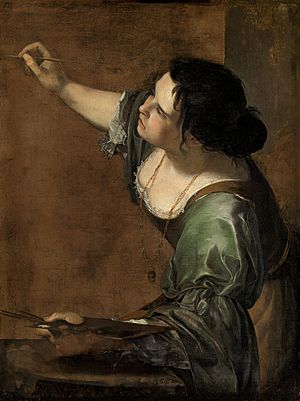
Self-Portrait as the Allegory of Painting, 1638–39
|
|
| Born | 8 July 1593 |
| Died | c. 1656 |
| Nationality | Italian |
| Known for | Painting |
|
Notable work
|
|
| Style | Baroque |
| Movement | Accademia delle Arti del Disegno |
| Patron(s) |
|

Artemisia Lomi or Artemisia Gentileschi ( 8 July 1593 – c. 1656) was an Italian Baroque painter. Gentileschi is considered among the most accomplished seventeenth-century artists, initially working in the style of Caravaggio. She was producing professional work by the age of 15. In an era when women had few opportunities to pursue artistic training or work as professional artists, Gentileschi was the first woman to become a member of the Accademia di Arte del Disegno in Florence and she had an international clientele.
Contents
Biography
Early life
Artemisia Lomi Gentileschi was born in Rome on 8 July 1593, although her birth certificate from the Archivio di Stato indicates she was born in 1590. She was the eldest child of Prudenzia di Ottaviano Montoni and the Tuscan painter Orazio Gentileschi. Orazio Gentileschi was a painter from Pisa.
Baptised two days after her birth in the church of San Lorenzo in Lucina, Artemisia was primarily raised by her father following the death of her mother in 1605. It was likely at this time that Artemisia approached painting: introduced to painting in her father's workshop, Artemisia showed much more enthusiasm and talent than her brothers, who worked alongside her. She learned drawing, how to mix colour, and how to paint. By 1612, aged 18, Artemisia was known for her exemplary talents, with her father boasting that, despite having only practised painting for three years, Artemisia was peerless.
During this early period of her life, Artemisia took inspiration from her father's painting style, which had in turn been heavily influenced by the work of Caravaggio. Artemisia's approach to subject matter was different from that of her father, however, taking a highly naturalistic approach over her father's comparatively idealised works.
Her earliest surviving work, completed aged 17, is Susanna and the Elders (1610, Schönborn collection in Pommersfelden). The painting depicts the Biblical story of Susanna. The painting shows how Artemisia assimilated the realism of and effects used by Caravaggio without being indifferent to the classicism of Annibale Carracci and the Bolognese School of Baroque style.
Florentine period (1612–1620)
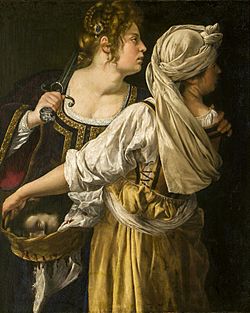
Orazio arranged for his daughter to marry Pierantonio Stiattesi, a modest artist from Florence. Shortly afterward the couple moved to Florence. The six years she spent in Florence would be decisive both for Artemisia's family life and professional career. Artemisia became a successful court painter, enjoying the patronage of the House of Medici, and playing a significant role in courtly culture of the city.
Artemisia's career as an artist was very successful in Florence. She was the first woman accepted into the Accademia delle Arti del Disegno (Academy of the Arts of Drawing). She maintained good relations with the most respected artists of her time, such as Cristofano Allori, and was able to garner the favour and the protection of influential people, beginning with Cosimo II de' Medici, Grand Duke of Tuscany, and especially of the Grand Duchess, Christina of Lorraine. Her acquaintance with Galileo Galilei, evident from a letter she wrote to the scientist in 1635, appears to stem from her Florentine years; indeed it may have stimulated her depiction of the compass in the Allegory of Inclination.
Her involvement in the courtly culture of Florence not only provided access to patrons, but it widened her education and exposure to the arts. She learned to read and write and became familiar with musical and theatrical performances.
In 1615, she received the attention of Michelangelo Buonarroti the Younger (a younger relative of Michelangelo). Busy with the construction of the Casa Buonarroti to celebrate his noted great uncle, he asked Artemisia—along with other Florentine artists, including Agostino Ciampelli, Sigismondo Coccapani, Giovan Battista Guidoni, and Zanobi Rosi—to contribute a painting for the ceiling. Artemisia was then in an advanced state of pregnancy. Each artist was commissioned to present an allegory of a virtue associated with Michelangelo, and Artemisia was assigned the Allegory of Inclination. In this instance, Artemisia was paid three times more than any other artist participating in the series. Artemisia painted her commission in the form of a young woman holding a compass. Her painting is located on the Galleria ceiling on the second floor. It is believed that the subject bears a resemblance to Artemisia. Indeed, in several of her paintings, Artemisia's energetic heroines appear to be self-portraits.
Other significant works from this period include La Conversione della Maddalena (The Conversion of the Magdalene), Self-Portrait as a Lute Player (in the collection of the Wadsworth Atheneum Museum of Art), and Giuditta con la sua ancella (Judith and her Maidservant), now in the Palazzo Pitti. Artemisia painted a second version of Judith beheading Holofernes, which now is housed in the Uffizi Gallery of Florence. Her first Judith Beheading Holofernes (1612–13), smaller in size, is displayed in the Museo di Capodimonte, Naples. In fact, she was fascinated with this subject and six variations of Judith Beheading Holofernes by Artemisia are known to exist.
While in Florence, Artemisia and Pierantonio had five children, but only one of them survived into adulthood.
Return to Rome (1620–1626/7)
Although it is sometimes difficult to date her paintings, it is possible to assign certain works by Gentileschi to these years, such as the Portrait of a Gonfaloniere, today in Bologna (a rare example of her capacity as portrait painter) and the Judith and her Maidservant today in the Detroit Institute of Arts. The Detroit painting is notable for her mastery of chiaroscuro and tenebrism (the effects of extreme lights and darks), techniques for which Gerrit van Honthorst and many others in Rome were famous.
Naples (1630–1656)
In 1630, Artemisia moved to Naples for the remainder of her career.
In Naples Artemisia started working on paintings in a cathedral for the first time. They are dedicated to San Gennaro nell'anfiteatro di Pozzuoli (Saint Januarius in the amphitheater of Pozzuoli) in Pozzuoli. During her first Neapolitan period she painted the Birth of Saint John the Baptist now in the Prado in Madrid, and Corisca e il satiro (Corisca and the Satyr), today in a private collection. In these paintings, Artemisia again demonstrates her ability to adapt to the novelties of the period and to handle different subjects, instead of the usual Judith, Susanna, Bathsheba, and Penitent Magdalenes, for which she already was known. Many of these paintings were collaborations; Bathsheba, for instance, was attributed to Artemisia, Codazzi, and Gargiulo.
It was once believed that Artemisia died in 1652 or 1653; however, modern evidence has shown that she was still accepting commissions in 1654. Some have speculated that she died in the devastating plague that swept Naples in 1656 and virtually wiped out an entire generation of Neapolitan artists.
Some works in this period are the Susanna and the Elders (1622) today in Brno, the Virgin and Child with a Rosary today in El Escorial, the David and Bathsheba today in Columbus, Ohio, and the Bathsheba today in Leipzig.
Artistic importance
Gentileschi was known for being able to depict the female figure with great naturalism and for her skill in handling colour to express dimension and drama.
She is now regarded as one of the most progressive and expressive painters of her generation, with the recognition of her talents exemplified by major exhibitions at internationally esteemed fine art institutions, such as the National Gallery in London.
Images for kids
-
Salome with the Head of Saint John the Baptist, c. 1610–1615, Budapest
-
Annunciation, 1630, Museo di Capodimonte
-
Lot and His Daughters, 1635–1638, Toledo Museum of Art
See also
 In Spanish: Artemisia Gentileschi para niños
In Spanish: Artemisia Gentileschi para niños


